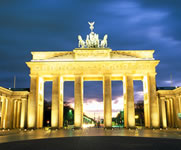Contact
Am Karlsbad 11
10758 Berlin
Email:
[email protected]
Internet:
www.visitBerlin.de
Districts

There seem to be no end of major attractions in Berlin's Mitte district. The Brandenburg Gate is Berlin's most famous landmark and the emblem of the city. "Unter den Linden", the famous boulevard, leads from here to the Schlossbrücke bridge and each of the buildings along it has its own story to tell. Humboldt University, the State Opera, the Comic Opera, the armoury and the Crown Prince's Palace are just a few of its best-known sights. The imposing group of grand classical buildings on Berlin Museum Island has been designated a UNESCO World Cultural Heritage site. Alexanderplatz square with its cold yet impressive high-rise buildings remains the centre of East Berlin, dominated by the 365-metre television tower. Elegant Friedrichstrasse's boutiques and upmarket department stores are places to shop and browse. Exclusive and quirky shops, chic cocktail bars and bohemian courtyards crowd together in the Hackesche Höfe complex. The reconstructed Nikolaiviertel quarter has preserved the charm of a small 18th century town. Gendarmenmarkt, designed by Schinkel and considered one of the most beautiful squares in Europe, with its Concert Hall and the German and French Cathedrals, lies close to the prominent domed building of St Hedwig's cathedral. Potsdamer Platz at the heart of Berlin extends across the Mitte and Tiergarten districts.
In recent years, Kreuzberg has become a fashionable area but has not lost its bohemian feel. Kreuzberg's multi-cultural life is a particular feature of the city's most populous district, once a melting pot of different nationalities, groups on the fringes of society, and the alternative scene when Berlin was a divided city. When the Berlin Wall fell, the area suddenly found itself in the geographical centre of Berlin and its proximity to the upmarket Mitte district brought the advent of fashionable restaurants and cocktail bars.
In the 19th century, Prenzlauer Berg was a traditional working-class district with five-storey tenement blocks dominating the skyline. The area went into decline under the GDR regime and became a focus for opposition movements. Numerous protest services and peace vigils were held in its churches in 1989. In recent years, Prenzlauer Berg has taken the place of Kreuzberg as the centre of autonomous, alternative culture. Schönhauser Allee is its main thoroughfare and shopping street and the area around the water tower is the place to stroll and relax.
Travel Planner
Select an option...
Map of Germany
Hotels in Berlin
Highlights in brief
- Brandenburg Gate
- Kurfürstendamm
- Victory Column
- Reichstag
- Planetarium
- Memorial Church
- Charlottenburg Palace
- Museums, Museum Island
- Wildlife park, zoo, aquarium
- Potsdam, Sanssouci Palace







